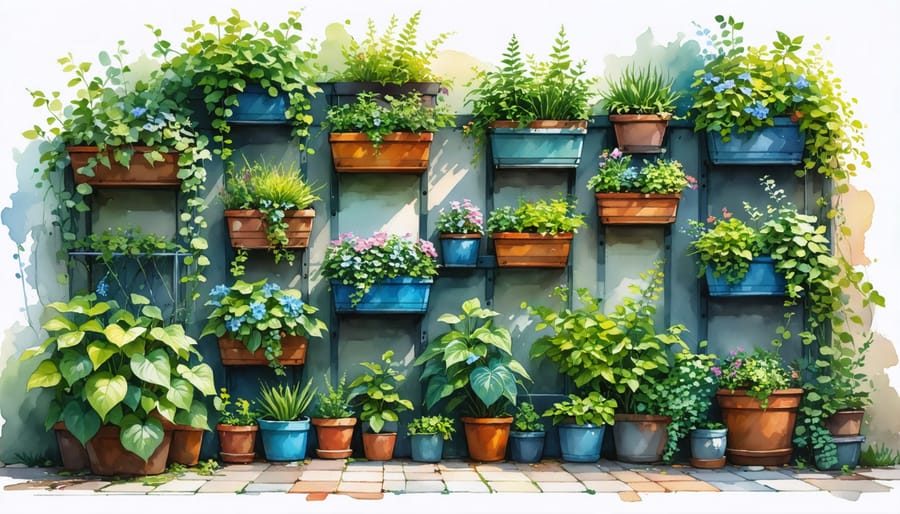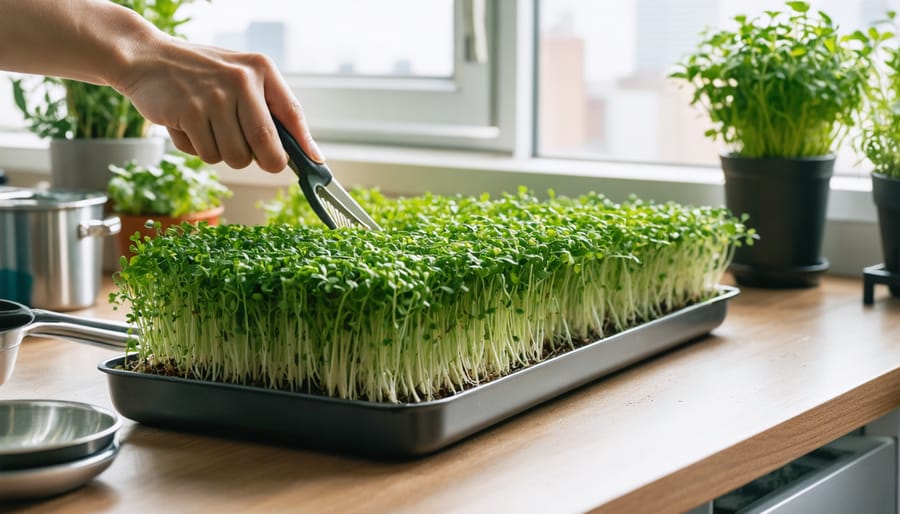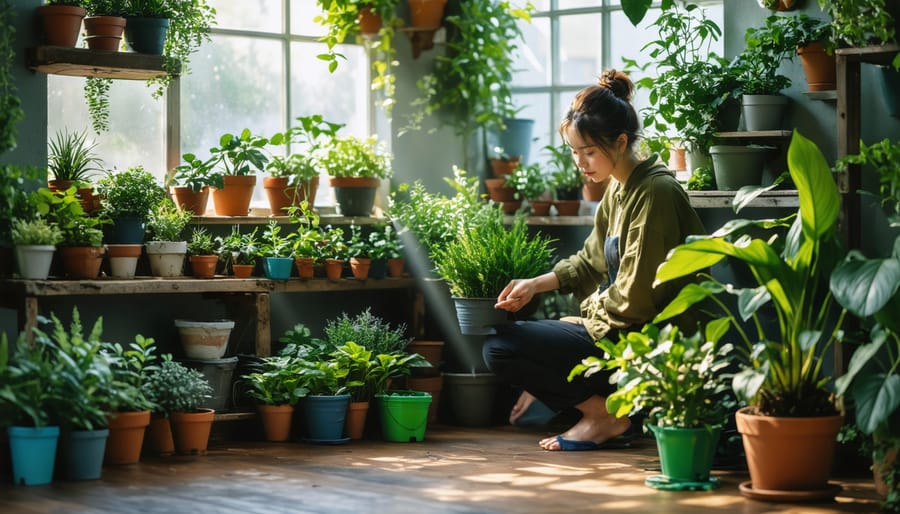Transform your windowsill, balcony, or tiny patio into a thriving garden oasis with smart vertical solutions and space-maximizing techniques. Urban dwellers and apartment gardeners regularly harvest fresh herbs, vibrant vegetables, and colorful flowers from spaces no larger than a coffee table. By thinking upward instead of outward, even the smallest spaces become productive growing environments.
The secret lies in strategic planning and selecting the right plants for your specific conditions. Wall-mounted planters, hanging baskets, and multi-tiered growing systems multiply your growing area without expanding your footprint. Compact varieties of tomatoes, leafy greens, and culinary herbs thrive in containers, while climbing plants like pole beans and cucumbers make excellent use of vertical space.
Modern container gardening has evolved far beyond traditional pots and planters. Today’s space-saving solutions include self-watering systems, stackable containers, and innovative growing techniques like hydroponic towers. These methods not only maximize limited square footage but also produce impressive yields that rival conventional gardens. Whether you’re working with a sunny windowsill or a shaded balcony, there’s a space-smart gardening solution waiting to transform your small space into a productive urban garden.
Understanding Your Shade Garden Space
Types of Shade: What You’re Really Working With
Before diving into plant selection, let’s focus on understanding light conditions in your space. Shade isn’t just shade – it comes in several varieties that can significantly impact your gardening success.
Full shade means an area receives less than 3 hours of direct sunlight daily, typically found on the north side of buildings or under dense tree canopies. Don’t worry though – plenty of beautiful plants thrive in these conditions!
Partial shade offers 3-6 hours of direct sunlight, usually during morning or late afternoon. These spots are perfect for many flowering plants and leafy vegetables. You’ll often find partial shade along east or west-facing walls.
Dappled shade is created when sunlight filters through tree branches, creating a lovely spotted pattern on the ground. Think of the shifting light beneath a maple tree – this gentle, filtered sunshine is ideal for woodland plants and many flowering perennials.
To identify your shade type, observe your space throughout the day. Take notes or photos at different times to track how sunlight moves across your garden. This simple step will help you choose the right plants for your specific conditions.

Making the Most of Limited Space
When dealing with a shaded garden in a small space, creativity becomes your best friend. To maximize limited growing space, consider vertical gardening solutions like wall-mounted planters or tiered shelving units. These not only save precious ground space but also create visual interest in your garden.
Try installing trellises against walls or fences for climbing shade-loving plants like climbing hydrangeas or Virginia creeper. Hanging baskets suspended at different heights can add depth while keeping pathways clear. For ground-level planting, use square-foot gardening techniques to organize your space efficiently.
Container gardening offers fantastic flexibility – you can move pots around to catch patches of sunlight or create interesting groupings. Choose containers with wheels for easier repositioning, and don’t forget about corner spaces, which often go unused. Stack crates or use ladder-style plant stands to create multiple growing levels.
Remember that mirrors and light-colored surfaces can help reflect what little light is available, making your space feel larger while benefiting your plants. Even the smallest shaded area can become a thriving garden with thoughtful planning and creative arrangement.
Best Plants for Small Shade Gardens
Compact Shade-Loving Plants
Limited space doesn’t mean limited options when it comes to shade-loving plants. These compact beauties are perfect for those cozy corners where sunlight is scarce.
Hostas are a go-to choice, with miniature varieties like ‘Blue Mouse Ears’ growing just 6 inches tall. They offer beautiful foliage and thrive in containers, making them ideal for small patios or balconies. Japanese Forest Grass (Hakonechloa) creates graceful, flowing movement in tight spaces while staying manageable at 12-18 inches.
For year-round interest, consider Heuchera (Coral Bells), which comes in stunning varieties like ‘Palace Purple’ or ‘Caramel.’ These compact plants rarely exceed 12 inches in height and provide gorgeous foliage colors from burgundy to lime green.
Looking for blooms? Astilbe ‘Lille’ reaches only 6 inches tall but produces delicate plumes of pink flowers. Hellebores are another excellent choice, offering winter blooms while maintaining a tidy 12-inch footprint.
Don’t forget about ferns! The Japanese Painted Fern stays compact at 18 inches and adds silvery highlights to dark corners. For truly tight spaces, the Button Fern grows just 12 inches tall and works beautifully in hanging baskets or wall-mounted planters.
Remember to group these plants according to their water needs, and you’ll create a lush, layered look even in the smallest shaded areas.
Vertical Shade Plants
Growing vertically is a game-changer when you’re working with limited space, and there are plenty of shade-loving plants that naturally reach for the sky. Climbing vines like English Ivy and Virginia Creeper thrive in shaded areas and can transform a bare wall or fence into a living tapestry. Japanese Forest Grass adds elegant movement and height to shady corners, while tall-growing Astilbe provides dramatic plumes of feathery flowers.
Consider installing trellises or lattice panels to support climbing plants. The classic Japanese Climbing Hydrangea is perfect for north-facing walls, producing clusters of fragrant white flowers while requiring minimal horizontal space. For edible options, try growing pole beans or peas on vertical supports – many varieties can tolerate partial shade and provide fresh harvests throughout the season.
Don’t overlook columnar plants like Irish Yew or Sky Pencil Holly, which grow naturally in narrow, upright forms. These architectural plants create visual interest without spreading outward. For indoor-outdoor flexibility, try growing Boston Ferns in hanging baskets or mounting staghorn ferns on boards – both thrive in shade and draw the eye upward.
Remember to layer your vertical plantings, combining different heights and textures. Place taller plants at the back, medium-height specimens in the middle, and trailing varieties at the front to create depth and interest in your limited space.
Container-Friendly Shade Plants
Just because your garden gets limited sunlight doesn’t mean you can’t create a stunning container display! Shade-loving plants often feature fascinating foliage and surprising blooms that can transform any dimly lit corner into a lush oasis.
Hostas are perfect container candidates, offering dramatic leaves in various patterns and colors. Their compact varieties, like ‘Blue Mouse Ears’ or ‘Patriot,’ are particularly well-suited for pots. Pair them with Japanese Forest Grass (Hakonechloa) for a graceful, cascading effect that adds movement to your space.
Ferns are another fantastic choice, with many varieties thriving in containers. The Japanese Painted Fern brings silvery fronds with burgundy highlights, while the Bird’s Nest Fern offers bold, wavy leaves that make a modern statement. These plants appreciate consistent moisture but good drainage, so choose containers with adequate drainage holes.
For seasonal color, consider Begonias and Impatiens, which reliably produce flowers even in deep shade. The trailing Fuchsia adds elegant, dangling blooms that attract hummingbirds. Coleus provides endless color combinations through its foliage alone, and many varieties stay compact in containers.
Don’t forget about hardy perennials like Heuchera (Coral Bells) and Astilbe, which offer both interesting foliage and delicate flower spikes. These plants return year after year, making them excellent investments for your container garden. Remember to group plants with similar water needs together for easier maintenance.

Smart Design Solutions
Vertical Gardening Techniques
When space is limited, thinking vertically opens up a world of growing possibilities, even in shaded areas. By utilizing vertical space, you can create a thriving garden that maximizes every square inch while adding visual interest to your outdoor space.
Start by choosing appropriate support structures for your vertical garden. Trellises, lattices, and wall-mounted planters work wonderfully in shaded spaces. For a budget-friendly option, repurpose old wooden pallets by mounting them on walls, or create a simple bamboo trellis system. These structures not only support your plants but also add architectural interest to your garden.
Climbing plants are natural choices for vertical gardens in shade. Consider growing hardy varieties like climbing hydrangeas, Virginia creeper, or English ivy. For edible options, try growing shade-tolerant peas or pole beans during cooler seasons when leaf coverage from nearby trees might be less dense.
Pocket planters and hanging baskets are excellent for creating living walls in shaded areas. Layer different plants at varying heights, considering their growth habits and maintenance needs. Ferns, hostas, and shade-loving flowering plants like fuchsias thrive in these vertical arrangements.
Remember to consider weight and water distribution when planning your vertical garden. Install proper drainage systems and ensure your support structures can handle the load of mature plants and wet soil. Regular maintenance is key – trim climbing plants to prevent them from becoming too heavy, and check support systems periodically for stability.
To maximize light exposure in shaded vertical gardens, position climbing plants and hanging elements at angles that catch available light. Using light-colored walls or supports behind your vertical garden can also help reflect what limited light is available to your plants.

Container Arrangements and Placement
Making the most of limited space starts with smart container placement. Think of your small garden as a three-dimensional canvas where you can arrange plants at different heights and depths. Begin by positioning larger containers at the back or along walls, creating a natural backdrop for smaller pots in front. This tiered approach not only maximizes space but also creates visual interest.
Consider grouping containers by watering needs to streamline maintenance. Place thirsty plants together, and group drought-tolerant varieties in another area. This practical arrangement makes daily care more efficient and helps prevent both over- and under-watering.
Vertical spaces are your secret weapon in small gardens. Install wall-mounted planters or hanging baskets at varying heights, and don’t forget about corners – they’re perfect spots for tall, narrow containers with climbing plants. Window boxes and railing planters can transform overlooked spaces into productive growing areas.
Color coordination plays a crucial role in container arrangements. Group containers with complementary colors, or create a cohesive look with matching pot styles. For a more dynamic display, mix and match container heights within each grouping – try the “thriller, filler, spiller” approach, combining tall statement plants with medium-height fillers and trailing varieties.
Remember to leave enough space between containers for air circulation and easy access for maintenance. Mobile containers on wheels or plant caddies offer flexibility, allowing you to adjust arrangements seasonally or move plants to catch optimal sunlight. In tight spaces, consider nesting smaller pots within larger ones, creating mini garden scenes that pack multiple plants into a smaller footprint.
Maintenance Tips for Small Shade Gardens
Watering and Fertilizing in Shade
Proper watering and fertilizing are key elements of growing successfully in shade. While shade gardens typically require less frequent watering than sunny spots, they need careful attention to moisture levels since the soil tends to stay damp longer. Check the soil moisture by inserting your finger about an inch deep – if it feels dry, it’s time to water.
When it comes to fertilizing, shade plants generally need less than their sun-loving counterparts. Use a balanced, slow-release fertilizer in early spring and mid-summer. Avoid high-nitrogen fertilizers, as they can promote leggy growth in low-light conditions. Instead, opt for a 5-5-5 or 10-10-10 formula.
Remember that roots compete for water and nutrients in shaded areas, especially near trees. Consider using a soaker hose or drip irrigation system to ensure water reaches plant roots effectively. Mulching with organic materials like leaf mold or composted bark helps retain moisture and slowly releases nutrients into the soil, creating ideal growing conditions for your shade-loving plants.
Pruning and Space Management
Regular pruning is your secret weapon when gardening in tight spaces. Think of it as giving your plants a gentle haircut to keep them healthy and manageable. For most plants, aim to trim them back by about one-third when they start looking crowded or leggy. This encourages bushier growth and prevents them from overwhelming their neighbors.
Start by removing any dead, diseased, or crossing branches. Then, shape the plant by making clean cuts just above leaf nodes or branching points. For climbing plants, don’t hesitate to train them horizontally along trellises or wires to maximize vertical space while maintaining accessibility.
Timing matters too! Spring and early summer are ideal for most pruning tasks, though some plants prefer different schedules. Keep your tools sharp and clean to make precise cuts that heal quickly and prevent disease spread.
Remember that regular maintenance is easier than major surgery – a quick weekly inspection and light trim will save you from having to tackle overwhelming growth later. Consider keeping dwarf varieties of your favorite plants, as they naturally require less aggressive pruning while still providing the same beauty and benefits.
Don’t let limited space hold you back from creating your dream garden! As we’ve explored, small-space gardening offers endless possibilities, from vertical solutions to container combinations. Remember that even the shadiest corners can become thriving green spaces with the right plant selection and care. Start small, perhaps with a few shade-loving containers, and gradually expand as your confidence grows. Experiment with different plant combinations, and don’t be afraid to adjust your garden as you learn what works best in your space. With proper planning, regular maintenance, and a bit of creativity, you can transform any modest area into a lush, peaceful retreat that brings joy throughout the seasons. Your small shade garden journey begins with a single plant – why not start today?




